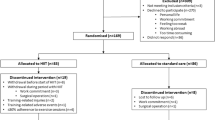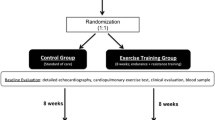Abstract
Background
Primary microvascular angina (PMA) is a common clinical condition associated to negative impact on quality of life (QOL) and reduced physical capacity. This study aimed at evaluating the effects of aerobic physical training (APT) on myocardial perfusion, physical capacity, and QOL in patients with PMA.
Methods
We investigated 12 patients (53.8 ± 9.7 years old; 7 women) with PMA, characterized by angina, angiographycally normal coronary arteries, and reversible perfusion defects (RPDs) detected on 99mTc-sestamibi-SPECT myocardial perfusion scintigraphy (MPS). At baseline and after 4 month of APT, the patients underwent MPS, cardiopulmonary test, and QOL questionnaire. Stress-rest MPS images were visually analyzed by attributing semi-quantitative scores (0 = normal; 4 = absent uptake), using a 17-segment left ventricular model. Summed stress, rest, and difference scores (SDS) were calculated.
Results
In comparison to the baseline, in the post-training we observed a significant increase in peak-VO2 (19.4 ± 4.8 and 22.1 ± 6.2 mL·kg−1·minute−1, respectively, P = .01), reduction of SDS (10.1 ± 8.8 and 2.8 ± 4.9, P = .008), and improvement in QOL scores.
Conclusions
Physical training in patients with PMA is associated with reduction of myocardial perfusion abnormalities, increasing of physical capacity, and improvement in QOL. The findings of this hypothesis-generating study suggest that APT can be a valid therapeutic option for patients with PMA.


Similar content being viewed by others
References
Camici PG, Crea F. Coronary microvascular dysfunction. N Engl J Med 2007;356:830-40.
Cannon RO III. Microvascular angina and the continuing dilemma of chest pain with normal coronary angiograms. J Am Coll Cardiol 2009;54:877-85.
Beltrame JF, Crea F, Camici P. Advances in coronary microvascular dysfunction. Heart Lung Circ 2009;18:19-27.
Lanza GA, Crea F. Primary coronary microvascular dysfunction: Clinical presentation, pathophysiology, and management. Circulation 2010;121:2317-25.
Cannon RO III, Epstein SE. “Microvascular angina” as a cause of chest pain with angiographically normal coronary arteries. Am J Cardiol 1988;61:1338-43.
Gulati M, Cooper-DeHoff RM, McClure C, Johnson BD, Shaw LJ, Handberg EM, et al. Adverse cardiovascular outcomes in women with nonobstructive coronary artery disease: A report from the Women’s Ischemia Syndrome Evaluation Study and the St James Women Take Heart Project. Arch Intern Med 2009;169:843-50.
Jespersen L, Hvelplund A, Abildstrom SZ, Pedersen F, Galatius S, Madsen JK, et al. Stable angina pectoris with no obstructive coronary artery disease is associated with increased risks of major adverse cardiovascular events. Eur Heart J 2012;33:734-44.
Atienza F, Velasco JA, Brown S, Ridocci F, Kaski JC. Assessment of quality of life in patients with chest pain and normal coronary arteriogram (syndrome X) using a specific questionnaire. Clin Cardiol 1999;22:283-90.
Shaw LJ, Merz CNB, Pepine CJ, Reis SE, Bittner V, Kip KE, et al. The economic burden of angina in women with suspected ischemic heart disease: Results from the national institutes of health—National Heart, Lung, and Blood Institute—sponsored Women’s Ischemia Syndrome Evaluation. Circulation 2006;114:894-904.
Phan A, Shufelt C, Merz NB. Persistent chest pain and no obstructive coronary artery disease. J Am Med Assoc 2009;301:1468-74.
Kaski JC, Garcia LFV. Therapeutic option for the management of patients with cardiac syndrome X. Eur Heart J 2001;22:283-93.
Crea F, Lanza GA. Angina pectoris and normal coronary arteries: Cardiac syndrome X. Heart 2004;90:457-63.
Hambrecht R, Wolf AM, Giellen S, Linke A, Hofer J, Erbs S, et al. Effect of exercise on coronary endothelial function in patients with coronary artery disease. N Engl J Med 2000;342:454-60.
Buchthal SD, den Hollander JA, Merz CN, Rogers WJ, Pepine CJ, Reichek N, et al. Abnormal myocardial phosphorus-31 nuclear magnetic resonance spectroscopy in women with chest pain but normal coronary angiograms. N Engl J Med 2000;342:829-35.
Bairey Merz CN, Pepine CJ. Syndrome X and microvascular coronary dysfunction. Circulation 2011;124:1477-80.
Panting JR, Gatehouse PD, Yang GZ, et al. Abnormal subendocardial perfusion in cardiac syndrome X detected by cardiovascular magnetic resonance imaging. N Engl J Med 2002;346:1948-53.
Pennell DJ. Cardiovascular magnetic resonance: Twenty-first century solutions in cardiology. Clin Med 2003;3:273-8.
Saghari M, Assadi M, Eftekhari M, Yaghoubi M, Fard-Esfahani A, Malekzadeh JM, et al. Frequency and severity of myocardial perfusion abnormalities using Tc-99m MIBI SPECT in cardiac syndrome X. BMC Nucl Med 2006;6:1.
Kaski JC, Rosano GM, Collins P, Nihoyannopoulos P, Maseri A, Poole-Wilson PA. Cardiac syndrome X: Clinical characteristics and left ventricular function. Long-term follow-up study. J Am Coll Cardiol 1995;25:807-14.
Lanza GA, Buffon A, Sestito A, Natale L, Sgueglia GA, Galiuto L, et al. Relation between stress-induced myocardial perfusion defects on cardiovascular magnetic resonance and coronary microvascular dysfunction in patients with cardiac syndrome X. J Am Coll Cardiol 2008;51:466-72.
Legrand V, Hodgson JM, Bates ER, Aueron FM, Mancini GB, Smith JS, et al. Abnormal coronary flow reserve and abnormal radionuclide exercise test results in patients with normal coronary angiograms. J Am Coll Cardiol 1985;6:1245-53.
Vermeltfoort IAC, Raijmakers PGHM, Bondarenko O, van Rossum AC. Correlation of myocardial perfusion on cardiac magnetic resonance versus myocardial perfusion scintigraphy in cardiac syndrome X. Open Nucl Med J 2009;1:9-14.
Cavusoglu Y, Entok E, Timuralp B, Vardareli E, Kudaiberdieva G, Birdane A, et al. Regional distribution and extent of perfusion abnormalities, and the lung to heart uptake ratios during exercise thallium-201 SPECT imaging in patients with cardiac syndrome X. Can J Cardiol 2005;21:57-62.
Eriksson BE, Tyni-Lenne R, Svedenhag J, Hallin R, Jensen-Urstad K, Jensen-Urstad M, et al. Physical training in syndrome X: Physical training counteracts deconditioning and pain in syndrome X. J Am Coll Cardiol 2000;36:1619-25.
Tyni-Lenne R, Stryjan S, Eriksson B, Berglund M, Sylven C. Beneficial therapeutic effects of physical training and relaxation therapy in women with coronary syndrome X. Physiother Res Int 2002;7:35-43.
Giallauria F, Acampa W, Ricci F, Vitelli A, Torella G, Lucci R, et al. Effects of exercise training started within 2 weeks after acute myocardial infarction on myocardial perfusion and left ventricular function: A gated SPECT imaging study. Eur J Cardiovasc Prev Rehabil 2012;19:1410-9.
Heaps CL, Parker JL. Effects of exercise training on coronary collateralization and control of collateral resistance. J Appl Physiol 2011;111:587-98.
Belardinelli R, Paolini I, Cianci G, Piva R, Georgiou D, Purcaro A. Exercise training intervention after coronary angioplasty: The ETICA trial. J Am Coll Cardiol 2001;37:1891-900.
Gielen S, Schuler G, Hambrecht R. Exercise training in coronary artery disease and coronary vasomotion. Circulation 2001;103:E1-6.
Kendziorra K, Walther C, Foerster M, Mobius-Winkler S, Conradi K, Schuler G, et al. Changes in myocardial perfusion due to physical exercise in patients with stable coronary artery disease. Eur J Nucl Med Mol Imaging 2005;32:813-9.
Dominguez-Rodriguez A, Abreu-Gonzalez P, Avanzas P, Gomez MA, Padron AL, Kaski JC. Cardiopulmonary exercise testing for the assessment of exercise capacity in patients with cardiac syndrome X. Int J Cardiol 2012;154:85-7.
Hiss FC, Lascala TF, Maciel BC, Marin-Neto JA, Simões MV. Changes in myocardial perfusion correlate with deterioration of left ventricular systolic function in chronic chagas’ cardiomyopathy. J Am Coll Cardiol Imaging 2009;2:164-72.
Acknowledgments
This study was supported by a research grant from Fundação de Apoio à Pesquisa do Estado de São Paulo (FAPESP, No. 2008/04140-3).
Disclosure
The authors declare that there is no conflict of interest.
Author information
Authors and Affiliations
Corresponding author
Rights and permissions
About this article
Cite this article
de Carvalho, E.E.V., Santi, G.L., Crescêncio, J.C. et al. Pilot study testing the effect of physical training over the myocardial perfusion and quality of life in patients with primary microvascular angina. J. Nucl. Cardiol. 22, 130–137 (2015). https://doi.org/10.1007/s12350-014-9949-6
Received:
Accepted:
Published:
Issue Date:
DOI: https://doi.org/10.1007/s12350-014-9949-6




